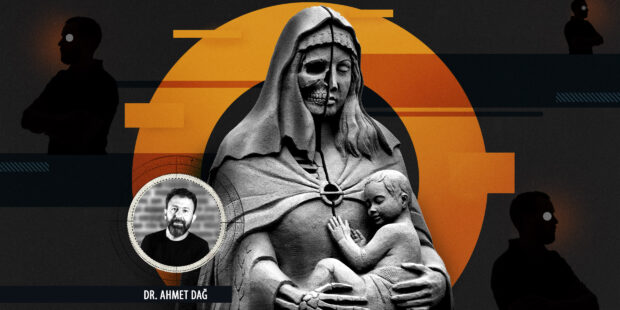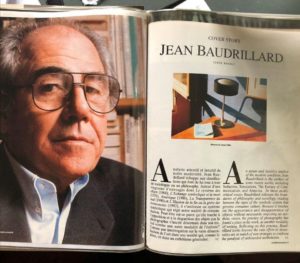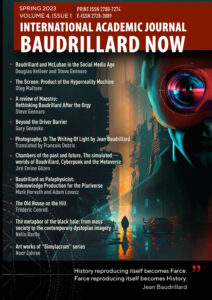
Baudrillard and the Forgetting of Death as a Challenge
by Dr. Ahmet Dağ
Death, a central subject in metaphysics, has become a concept that modern humans strive to exclude from their consciousness and daily life. Unlike classical man, who accepted death as a part of life, modern man finds it an uncomfortable topic to confront. Instead of fearing death, there is a tendency to trivialize or mock it. Adorno, considering death as ‘true dignity,’ attributes the contemporary human tendency to ignore death to a loss of hope in an afterlife and the bleak misery of the present. He argues that in the modern world, where living beings are reduced to outputs of the social system, death has been domesticated and degraded, rendered absurd by the culture industry’s lens. The culture industry and modernity have eroded and distorted death’s imagery, reducing the corpse to merely a stage prop resembling a human but devoid of essence.
Expanding on Adorno’s discourse, Baudrillard suggests that humanity, indifferent to death as to its own members, is a form of ‘dead’ humanity. He observes that contemporary culture expends enormous energy to dissociate life from death. In his view, death, now portrayed as ‘not scary,’ ‘fun,’ and ‘glamorized,’ occupies a different role in our era. In the modern age, death is transformed into a simulacrum through cinema and TV, while funeral homes present the deceased as ‘smiling,’ ‘more alive than before,’ and ‘seemingly communicative.’ Baudrillard argues that modernity, rooted in image and imitation, objectifies death by cloaking it in the hues of life. He asserts that death, in the guise and function of a naturalized, ‘fraudulent,’ and ‘idealized’ simulacrum, is assimilated into modernity and circulates among the living.
According to Baudrillard, who characterizes death as a ‘contradiction,’ ‘reversal,’ and ‘symbolic challenge,’ death induces chaos in modern capitalist societies due to its inability to be symbolically exchanged. He posits that through the symbolic—an act of exchange that nullifies the real and dissolves the dichotomy between the real and the imaginary—life and death are relegated to the realm of the imaginary. Death, seen as a threat to life and rendered futile, is also assimilated into contemporary news systems as a form of ‘metastatic death.’ It is transformed into information, its meaning predetermined and integrated into news systems and films. Baudrillard argues that this process not only artificializes death but also detaches life from its inherent truth, engulfing it in ‘artificiality.’ Life, amidst phenomena and objects labeled as ‘polluting,’ ‘sensitive,’ and ‘outdated’—specific to modern man and times—and within a technological environment and culture characterized by overproduction, is estranged from its original essence. This leads to the creation of an artificial ‘death’ environment.
Baudrillard observes a historical shift in the placement of graves: initially located within homes, they were later moved to cities, and in modern times, as the dead became marginalized, they were expelled from urban spaces. He notes that in contemporary societies, the dead, being removed from daily life, are cast out of the city, effectively vanishing from public view. Baudrillard further comments on the modern handling of death, stating, ‘Necropolises of death, which are not where they are supposed to be, are white spaces free from all kinds of human noise, with basements and halls filled with computers.’ This statement suggests that death, traditionally a tangible and visible part of life, has become obscured in the digital age, lost amidst TV and web networks, and relegated to sterile, technology-filled environments.
The philosopher argues that there is a scientific endeavour to nullify death, but this alone is insufficient; there’s also an effort to erase death from contemporary life. This erasure is facilitated through social media, where sharing photographs with dying relatives does more to devalue and erase the meaning of death than to acknowledge it. Death is transformed into a spectacle, detached from its true essence. Baudrillard, who passed away in 2007 and thus did not witness these specific social media trends, described the modern approach to death by stating, ‘…It is both the only way of sharing death specific to the modern world and a way of dying that no one is absolutely interested in.’ This statement captures his perspective on the unique, yet disinterested, manner in which death is treated in the modern era.
Baudrillard, viewing life and death as two inseparable truths, considers life as a value, while death represents the reproduction of time as a general equivalent. He perceives death not as a separation or regression but as a reversal and a symbolic challenge. For Baudrillard, death serves as a reminder of both life and mortality, and he identifies the desire to eliminate death as the primary reason for the loss of meaning in life and human existence. Echoing Heidegger, he believes that death is what imparts meaning, unity, integrity, and functionality to life.
Baudrillard asserts that a system distancing itself from death inevitably distances itself from life over time. He notes that while primitive societies with a symbolic exchange order maintained a symbolic exchange relationship between life and death, the capitalist order of modern societies has severed this relationship. Exchange has been reduced to mere objectification, and death has been objectified. He argues that life, in losing all its vitality, has become akin to death. Despite modern society’s efforts to banish death from life and ‘kill’ death, Baudrillard contends that the system we live in is pervaded by the scent of death.
Analyzing the concepts of ‘the dead’ and ‘death’ within what he calls ‘an existing dead order’ of simulation, Baudrillard observes that in modern societies, death and the dead are increasingly marginalized. He notes that while specific spaces are designated for the insane, criminals, and the ‘normal,’ no program, time, or space can be anticipated for the dead, as society is at a loss about how to handle them. This dilemma was starkly evident during the early stages of the Covid-19 pandemic, as seen in countries like Italy, where the capacity of crematoriums was overwhelmed, necessitating the transportation of the dead to facilities in other cities or countries. Furthermore, the rise of ‘green funerals’ or ‘human composting’ in the USA since its legalization in 2019, touted as an environmentally friendly alternative to burial and cremation, reflects this ongoing struggle to find appropriate ways to deal with death.
Baudrillard also comments on the diminishing significance of the soul-body duality on a materialist basis and the impact of the ‘death of God’ or its declaration, which he believes has led to a weakening in the meaning of humanity. He references Nietzsche’s proclamation ‘God is dead’ and develops an original discourse on God’s position within the order of simulation. Nietzsche’s foresight that ‘the death of God has already begun to cast its shadow over Europe’ influences Baudrillard’s view of the Western world. He envisions a world where even God is simulated, religion is reduced to visual technology based on images, and icons replace divine power, leading to a space where the ‘metastases of the death of God’ are experienced through the subversion of values. In Baudrillard’s perspective, God, content with his own death’s metastases, has perished in the world of simulation, where the loss of truth renders the existence of a true God impossible.
In Baudrillard’s concept of a world of simulation—a technically perfect ‘golden age’ unworthy of God’s glory but indicative of his death—reality or truth has morphed into allegory. In this world, God has not only disappeared, but even the question of his existence is obscured. Modern man, confronted with the reality of God’s absence, has assumed the responsibility of navigating a world where values are inverted in the wake of God’s death, and the immediate verification of God, unattainable in another realm, becomes a focal point. In this technically perfected world, where truth is allegorized, Baudrillard suggests that the ‘dead’ God is omnipresent, and churches have been erected to conceal this death. In the hyper-modern world, these ‘churches’ are social media platforms and chat rooms, where awe is pursued and actions are executed.
Baudrillard posits that we are in an era where the archaic man, who embalmed his corpse to assert his divinity, has been supplanted by the modern man who, despite advancements in medicine, feels no need for such practices. Modern man abandons the pursuit of immortality as a challenge to God, yet paradoxically seeks a different form of immortality through life extension or integration with machines. The quest for eternity shifts from the afterlife to the present world, fostering the belief that heaven and eternity are attainable in this life. Furthermore, we are witnessing a time where people not only resort to ‘human fertilization’ techniques but also aspire to merge their minds with machines (artificial intelligence) in a quest for immortality.
Baudrillard highlights the growing disconnect between life and death and the shift of control over death from divine to human hands, leading to changes in the forces determining human mortality and introducing uncertainty about the nature of human death. This uncertainty is amplified by the transformation of human beings through advancements in science and technology, such as artificial intelligence, genetics, biotechnology, and molecular biology, fuelling the desire to alter human destiny. Baudrillard articulates this uncertainty with the following statement: ‘The only certainty is that we have lost the thread of our own shroud on the scales of death. We now live in an extraordinary period of waiting and suspension, symbolized by nuclear power. As objective hostages to a terrifying god, we remain unsure about the event or accident that will ultimately seal our fate, and who will be responsible for it.


